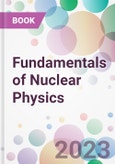Fundamentals of Nuclear Physics gives elementary understanding of nuclear and particle physics. The textbook offers an overview of the subject, providing students with a basic understanding about 1) the atomic structure and the nucleus, 2) equipment such as particle detectors, particle accelerators, and nuclear reactors, 3) radioactivity, and 4) elementary particles. Each chapter provides fundamental theoretical and experimental knowledge required for students to strengthen their concepts.
Other key features of the book include:
- Structured chapters designed for easy reading and stimulating interest for learners
- Sophisticated figures
- Thoroughly solved equations
- Bibliographic references for further reading
- Updated information about different types of nuclear reactors
- Information about nuclear astrophysics
Fundamentals of Nuclear Physics is suitable for introductory undergraduate courses in nuclear physics as well as more innovative courses geared towards nuclear engineering.
Table of Contents
Chapter 1 1. Introduction to Nuclei
1.1. Constituents of the Nucleus and Its Properties
1.1.1. Proton
1.1.2. Neutron
1.1.3. Nucleon
1.1.4. Nomenclature
1.1.5. Atomic Mass Unit, (U)
1.1.6. Nuclear Size and Density
1.1.7. Nuclei
1.2. Mass Defect and Binding Energy
1.2.1. Mass Defect
1.2.2. Binding Energy
1.3. Nuclear Reaction
1.3.1. Q-Value of Nuclear Reaction
1.4. Discovery of Neutron
1.5. Nuclear Chain Reaction
1.5.1. Types of Chain Reaction
- References
Chapter 2 Nuclear Fission and Fusion
1. Introduction
1.1. Nuclear Fission Basics
1.1.1. Nuclear Fission Energy
1.1.2. Fission Products
1.1.3. Fission Barrier
1.1.4. Moderation and Thermalization of Neutron
1.2. Nuclear Fusion
1.2.1. Elementary Reaction for Energy Discharge in the Sun by Fusion
1.2.2. Elementary Reaction for Energy Discharge in the Sun by Fusion
- References
Chapter 3 Nuclear Structure and Properties of Nuclei
1. Introduction
1.1. Atomic Models
1.1.1. Rutherford Model of the Atom
1.2. Nuclear Composition
1.2.1. Proton-Electron (P-E) Theory
1.2.2. Proton-Neutron (P-N) Hypothesis
1.3. Nuclear Properties
1.3.1. Nuclear Size
1.3.2. Nuclear Spin
1.3.3. Parity
1.3.4. Statistics
1.3.5. Nuclear Magnetic Dipole Moment
1.3.6. Quadrupole Moment
1.3.7. Nuclear Mass
1.4. Determination of Mass
1.4.1. Bain Bridge’S Mass Spectrograph
1.4.2. Bain Bridge and Jordon Spectrograph
1.5. Determination of Charge
1.5.1. Mosely’S Law Explanation
1.5.2. Applications of Mosley's Law
- References
Chapter 4 Particle Detectors
1. Introduction to Particle Detectors
1.1. G. M. Counter (Geiger-Muller Counters)
1.1.1. Principle, Construction and Working
1.1.2. Characteristics of G M Counter
1.1.3. Plateau Characteristics of G. M. Counter
1.1.4. Important Parameters Which Decide the Quality of Functioning of Gm Tubes [
1.1.5. Main Features of a Geiger-Muller Counter
1.1.6. Advantages and Disadvantages of G. M. Counter
1.2. Wilson Cloud Chamber
1.2.1. Principle, Construction and Working Wilson Cloud Chamber
1.2.2. Paths of the Particles Traced by Wilson Cloud Chamber
1.2.3. Applications of Wilson Cloud Chamber
1.3. Scintillation Counter
1.3.1. Principle of Operation
1.3.2. Efficiencies of Scintillation Detector
1.3.3. Applications of Scintillation Detector
1.4. Semiconductor Detector
1.4.1. Principle of Operation
1.4.2. Types of Semiconductor Detectors
- References
Chapter 5 Particle Accelerators
1. Introduction
1.1. Significant Categories of Particle Accelerator
1.2. in What Manner Does a Particle Accelerator Performs
2. Linear Accelerator (Linac)
2.1. Construction of Linear Accelerator
2.2. Working of a Linear Accelerator
2.3. Calculation of Length of Drift Tube
2.4. Calculation of Energy of the Particle
3. Cyclotron
3.1. Principle, Construction and Working of Cyclotron
3.2. Cyclotron Radiation
3.3. Applications of the Cyclotron
3.4. Advantages of the Cyclotron
3.5. Limitations of Cyclotron
- References
Chapter 6 Nuclear Reactors
1. Introduction
1.1. Principle of Operation
1.2. Fission
1.3. Generation of Heat
1.4. Fission Reactions Rate Mechanism
1.5. Cooling System
1.6. Power Generation
2. Important Components of Nuclear Reactor
2.1. Construction of Nuclear Reactor
2.2. Advantages
2.3. Disadvantages
2.4. Significant Types of Nuclear Reactor
2.4.1. Thermal Reactors
2.4.2. Heavy Water Moderator Reactors
2.4.3. Graphite-Gas Moderator Reactors
2.4.4. Fast Neutron Reactors (Fnr)
2.5. Fnr Features
2.5.1. Fuel Cycle in Fnr
2.6. Accelerator-Driven Subcritical Reactor (Adsr)
2.6.1. Operational Principal in Adsr
2.6.2. The Spallation Target and Sub-Critical System
2.6.3. The Sub-Critical System
2.6.4. The High Intensity Beam Accelerator
2.7. The Oklo Ancient Nuclear Reactor
2.7.1. Ancient Background
2.7.2. Foundation of Natural Fission Reactors
2.7.3. Innovations from Oklo
2.8. Existing Technologies
2.8.1. Pressurized Water Reactors (Pwr)
2.8.2. Boiling Water Reactors (Bwr)
2.8.3. Pressurized Heavy Water Reactor (Phwr)
2.8.4. Gas-Cooled Reactor (Gcr) and Advanced Gas-Cooled Reactor (Agr)
2.8.5. Liquid Metal Fast-Breeder Reactor (Lmfbr)
2.9. Lead-Cooled
2.
2.
0.2. Aqueous Homogeneous Reactor (Ahr)
- References
Chapter 7 Radioactivity
1. Introduction to Radioactivity
1.1. Alpha (Α) Rays
1.2. Beta (Β) Rays
1.3. Gamma (Γ) Rays
2. Alpha, Beta and Gamma Decay
2.1. Origin of Alpha Decay
2.1.1. Properties of Alpha Rays
2.1.2. Example
2.2. Magnetic Spectrometer
2.2.1. Determination of Energy of Α (Alpha) Particle
2.2.2. Stopping Power
2.2.3. Range of Alpha Particles
2.3. Experimental Determination of Range of Α-Particle
2.3.1. Geiger’S Law
2.3.2. Geiger-Nuttal Law
2.4. Alpha Particle Tunneling
2.5. Gamow’S Theory of Alpha Decay
(A). For Region I
(B). For Region Ii
(C). Region Iii
- Boundary Conditions
3. Beta Decay
3.1. Beta Minus Decay
3.2. Beta Plus Decay
3.3. Electron or K-Capture
3.4. Measurement of Energy of Beta Particle
3.5. Energy Spectrum of Beta (Β) Particles
3.6. Neutrino Theory of Beta Decay
3.6.1. (Pauli’S Neutrino Hypothesis)
3.6.2. Neutrino Properties
3.7. Fermi Theory of Beta Decay
4. Gamma Decay
4.1. Example
4.2. Measurement of Gamma Γ-Ray Energies
4.3. Magnetic Spectrograph for Energetic Photoelectrons (Γ-Ray)
4.4. Detection of Energy of Photoelectrons
4.5. Dumond Bent Crystal Spectrometer
4.6. Pair Spectrometer for Determination of Gamma-Ray Energy
5. Applications of Radioactivity
5.1. in Science
5.2. in Medicine
5.3. in Industry
- References
Chapter 8 Origin and Applications of Radioactivity
1. Introduction
1.1. Origin of Radioactivity
1.2. Fossil Radioactivity
1.2.1. Radioactive Dating of Fossils
1.2.2. Isotopes Used for Dating
1.3. Half-Life
1.3.1. Short Range Dating
1.3.2. Long Range Dating
1.3.3. Other Dating Techniques
1.4. Index Fossils
1.5. Electron Spin Resonance
1.6. Cosmogenic Radioactivity
1.7. Artificial Radioactivity
1.8. Applications of Radioactivity
1.8.1. Medicinal and Pharmaceutical Applications
1.8.2. Diagnostic Purpose
1.8.3. Therapeutic
1.8.4. Nuclear Dating
1.8.5. Industry and Engineering Applications
Author
- Ritesh Kohale
- Vibha Chopra
- Sanjay J Dhoble








